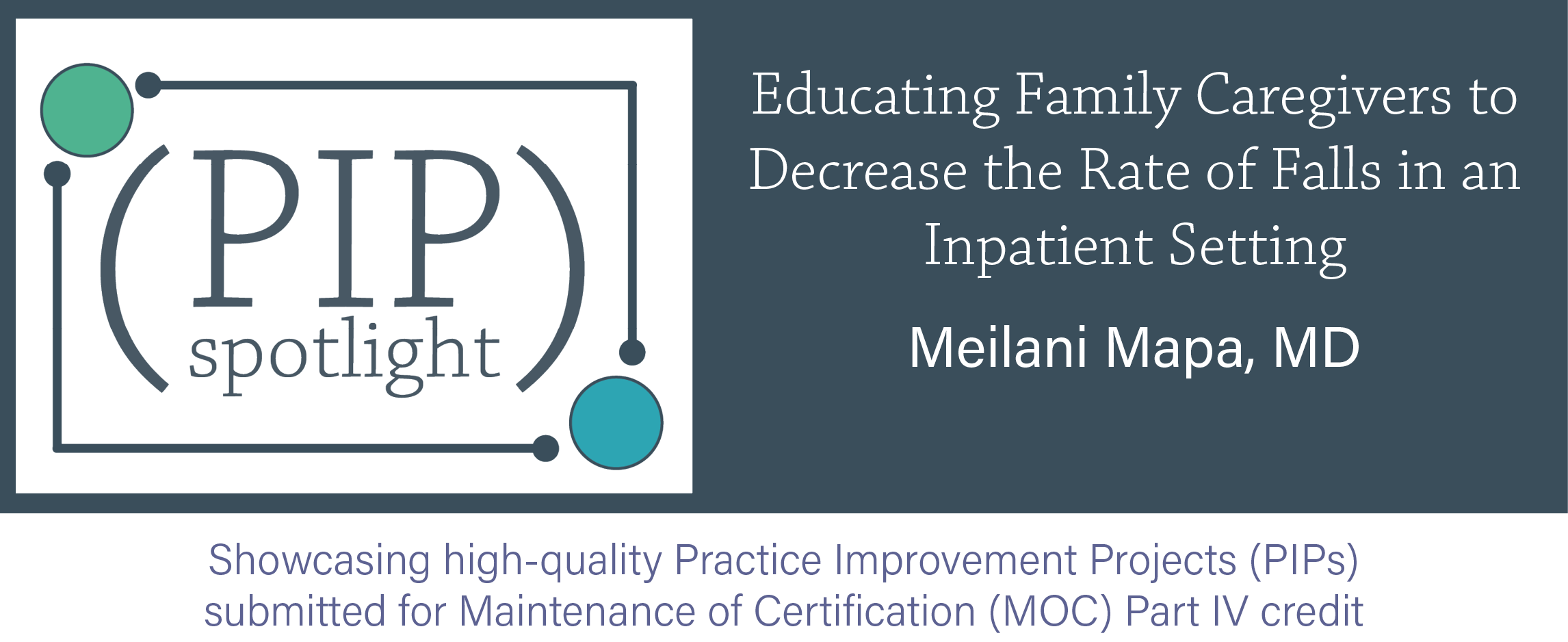CC
PIP Spotlight: Educating Family Caregivers to Decrease the Rate of Falls in an Inpatient Setting

July’s PIP Spotlight was submitted by Meilani Mapa, MD. Dr. Mapa implemented a training program for families of patients to decrease the number of falls at her rehabilitation facility. As a program director and a treating physician serving in public healthcare, Dr. Mapa wanted to improve patient safety by initiating fall-prevention training for hands-on caregivers.
The PIP Spotlight is a periodic feature on News Center to highlight exemplary Practice Improvement Projects submitted by your fellow diplomates for Maintenance of Certification (MOC) Part IV credit.
Diplomates can use the PIP Spotlight as a tool to model additional PIPs on what you read here, or as a way to connect with other diplomates doing similar work.
Thanks to Dr. Mapa for her Practice Improvement Project submission!

What is the problem you are trying to solve?
With over 2,000 admissions annually, including a high concentration of neurologically impaired patients, we recognized the need to initiate an intervention aimed at minimizing the risk of family-related falls in our population. Data collected from post-fall interviews with patients and family members led the team to realize that hands-on caregiver training needed to be initiated much earlier in the patient’s stay.
What data (objective measurements) do you have that supports this as a problem?
Literature indicates that fall rates vary by type of unit, with the highest rate occurring in the neurosciences (6.12-8.83/1,000 patient days). In 2017, our 89-bed adult inpatient rehabilitation program realized an unassisted fall rate of 5.65%, exceeding our benchmark of 4.25% for January through April 2015. Data review identified an increasing trend of family-related falls in a 16-month period between January 2016 and May 2017.
What is your opportunity statement? State the goal you hope to achieve.
In three months, we will decrease family-related falls in the Rehabilitation population by 10% through implementation of a proactive caregiver education program.
What is the underlying cause of the performance/quality problem?
From the interviews conducted by staff after a family-related fall, multiple family members stated that they felt they were part of the team and wanted to help the staff by assisting the patient on their own rather than “bothering” the staff. They would say things like:
- I’ve been here every day and observed multiple therapy sessions.
- I saw how he transferred in therapy today.
- I thought I knew how to do the transfer, I guess I didn’t have the experience.
As a result of these interviews, the team (quality, physicians, nursing and therapy) realized that hands-on caregiver training needed to be initiated much earlier in the patient’s stay in a proactive, organized, caregiver education program.

What change(s) did you implement?
The intervention program, called Family in Training (FIT), was developed collaboratively by the inpatient rehabilitation team: nursing, therapy, quality, and physicians. The FIT program was designed to organize and standardize an approach to early caregiver training. The goal of the program was to engage family members earlier in the patient’s hospital stay to partner in care and become active team members. Early in the patient’s rehabilitation stay, families are trained on five elements deemed essential to safely care for the patient:
- Bed to chair transfers
- Walking
- Wheelchair management
- Toilet transfer
- Toileting
Once the family member is deemed competent in these areas, they are issued a bright orange wrist band to wear that is labeled "Family in Training.” This band communicates to the staff that this family member is able to independently assist the patient in the five areas listed.

Did you achieve your goal or target from your opportunity statement? What data do you have to support your conclusion?
The intervention exceeded the set goal of decreasing family-related falls on our rehab unit. In six months, the intervention decreased family-related falls by 90%. Only one patient had a family-related fall in the six-month intervention period after training 69 families (1/69).

Will you continue with the changes you have implemented?
After one year of this intervention we have shown a continued decrease in family-related falls. One fall was noted in 12 months (1/166). Through August 2018, 246 families were trained, and we only had two family-related falls post-FIT training.
In addition, the patients/families who participated in the FIT program also had an increased likelihood to be discharged to home, a higher Functional Independence Measure (FIM) change, improved patient satisfaction, and no fall-related readmissions within 30 days of discharge.
Due to the success of this program, we are encouraging more family members to be FIT trained while their family members are in rehabilitation. We have also presented our data to other hospitals in our healthcare system. While this intervention helped decrease family-related falls, we continue to have other types of falls including staff-related falls or unassisted falls. We continue to meet monthly as a falls committee to discuss these issues and collaborate on other fall-related QI projects.



